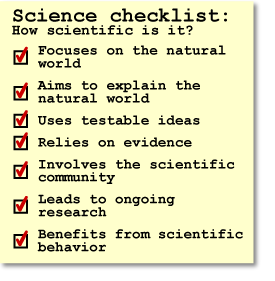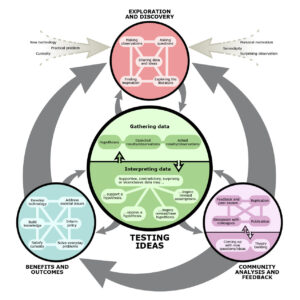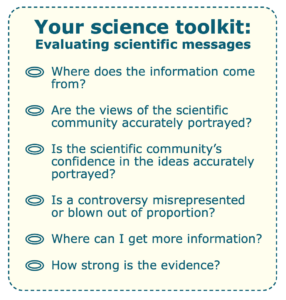These three tools can help you reinforce key concepts regarding the nature and process of science with your students:
 The Science Checklist examines what makes science science — the key features that set science apart from other human endeavors. Suggested use by students: The checklist was developed to help people distinguish scientific investigations from non-scientific ones. This concept can be introduced to students at this level in a variety of ways:
The Science Checklist examines what makes science science — the key features that set science apart from other human endeavors. Suggested use by students: The checklist was developed to help people distinguish scientific investigations from non-scientific ones. This concept can be introduced to students at this level in a variety of ways:
- Have students read about scientists and their work and apply the science checklist.
- Bring in examples of different sorts of investigations (e.g., SETI’s studies of astrobiology vs. those of the National UFO Reporting Center), and have students apply the checklist to them to see how scientific they are.
 The Science Flowchart provides a representation of how science really works.You may want to download a copy of the flowchart poster, hang it in your room, and underscore connections to the flowchart components throughout the school year. See Introducing the Science Flowchart for ways to introduce the flowchart to your students. Suggested use by students: The Science Flowchart can provide a good reference for your students (1) to make elements of the process of science explicit, and (2) to help them reflect on their scientific approach to investigations of their own.
The Science Flowchart provides a representation of how science really works.You may want to download a copy of the flowchart poster, hang it in your room, and underscore connections to the flowchart components throughout the school year. See Introducing the Science Flowchart for ways to introduce the flowchart to your students. Suggested use by students: The Science Flowchart can provide a good reference for your students (1) to make elements of the process of science explicit, and (2) to help them reflect on their scientific approach to investigations of their own.
- Have students design the procedures for a short investigation. Students can describe how their procedures illustrate various parts of the process of science and discuss the different pathways followed.
- Have students plan a long-term investigation. Students will address a specific question and test hypotheses. You may want to ask them provide a written report that includes methods used, data collected, interpretation of the data, and a list of resulting questions. Students can reflect on the process of science by charting their pathway on the Science Flowchart. Have students read about scientists and their investigations (e.g., Asteroids and dinosaurs: Unexpected twists and an unfinished story). Students can chart the pathways of the different investigations and discuss how and why their courses differed.
- Select a series of videos from a source such as Science Friday (e.g., Surveying the Northern Lights or The Lake Sentinel) for your students to watch. Ask them to identify the connections to the Science Flowchart.
 Your Science Toolkit provides a set of questions that can help your students apply critical thinking skills, evaluate media messages about science, and improve their own decision-making. When considering a scientific message or policy, students should be encouraged to ask how we know this and to consider sources of information, quality of evidence, and potential biases and misrepresentation. Suggested activity for students:
Your Science Toolkit provides a set of questions that can help your students apply critical thinking skills, evaluate media messages about science, and improve their own decision-making. When considering a scientific message or policy, students should be encouraged to ask how we know this and to consider sources of information, quality of evidence, and potential biases and misrepresentation. Suggested activity for students:
- Look for “Hype Headlines” such as Miracle of gene therapy right around the corner and discuss with students. Start a bulletin board of examples that students find in the print media.
- Have students observe a series of commercials on television or print advertisements from magazines or the local newspaper. Have students apply appropriate questions from the toolkit. Discuss in class.
- Have students Google a topic such as hamburger nutrition and find examples of both reliable and unreliable resources. Ask them to explain their reasoning.
